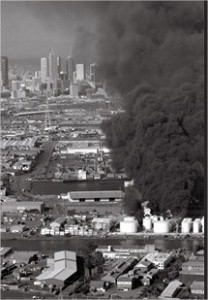At 2.17 pm a sequence of events took place leading to a major fire at bulk chemical depot. The 1.5 ha site contained 39 vertical tanks and 7 horizontal ones. In all, 18,000 m³ of benzene, 650 m³ acrylonitrile, 500 m³ phenol, 500 m³ butanol and 500 m³ MEK were stored. The tanks sit within 8 bunds (2-3 m high, made of earth with limited concreting).
An early event was the rising up into the air of tank n°80 which contained acrylonitrile (vinyl cyanide) monomer, the discharging of its contents into the tank bund and the crashing down of the tank and associated pipework and pump, onto the main fire-fighting water and foam lines of the plant adjacent to the office building.
Shortly after, tank n°81 which contained molten phenol and was located in the same bund, rose into the air and landed near to benzene tank no 79. A very large fire ensued in the tank bund area and in a relatively short period of time, a number of other tanks became involved (through the interconnecting vapour recovery system pipework or fire-fighting foam network) and either blew off their lids or collapsed in place. The truck-fill stand and two trucks previously loading benzene quickly became involved as did the nearby drum-filling area.
The incident was substantially over later that afternoon but flared up again the following day to an inferno of similar scale, following inability to extinguish a residual flange fire emanating from methyl ethyl ketone (MEK) tank n°69. No lives were lost, no significant injuries caused and the fires were fully extinguished on the second day. There were no major off-site effects, except community disturbance during fire-fighting operations (evacuation of thousands of people in a 2 km radius) and thick black irritating smoke over the city. Material damage was estimated at 11 M Australian dollars.
The event required large quantities of fire fighting foam (450 m3) and specialised tenders to be borrowed from the Airport. 27 tanks were either destroyed or seriously damaged : 8.5 million litres of chemicals were lost but by preventing the fire spreading to other sites, the fire-fighting effort saved 19 million litres. 14.5 millions m3 of contaminated fire fighting water and about 500 t of product in damaged tanks were withdrawn during clean-up.
It was officially concluded on the balance of probabilities’ that the cause was an explosion in the vapour space of acrylonitrile tank 80 following a strike of St Elmo’s Fire’ or corona discharge entering through the pressure/vacuum relief valve (PV-valve) at the top of the tank.
However, another theory is given, based on eye witnesses not called to court and indicating that the cause was an explosion and fire at ground level near to tank n°80 that was being loaded at that time. A major leak of a pipeline (e.g. due to a wrong flexible pipe connection) followed by the ignition by welding activity, static electricity or overheated pump seal could then become plausible causes.




